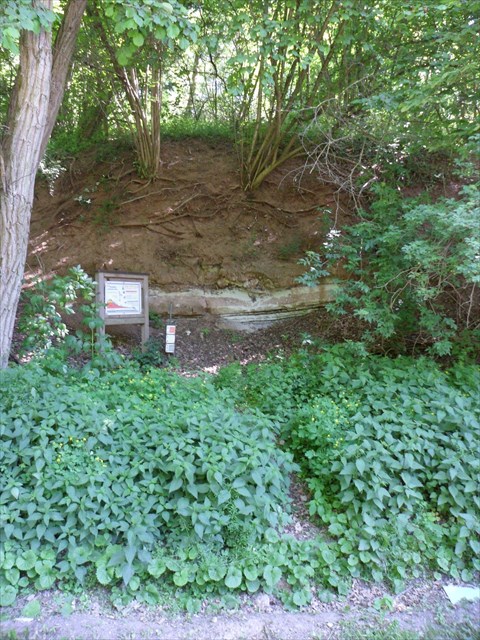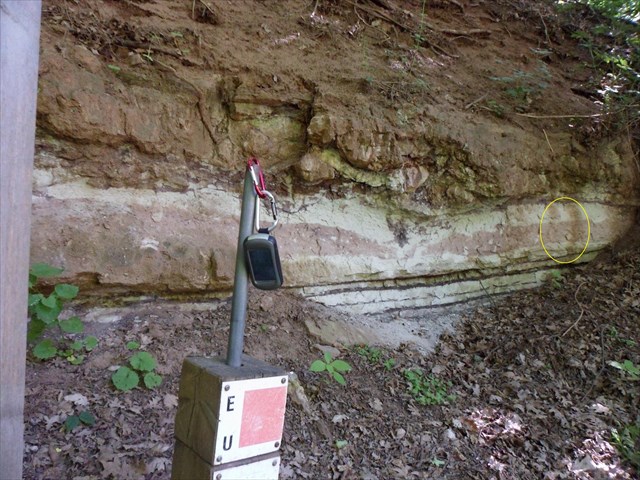Der Kreuzberg - geologischer Aufbau
Der Kreuzberg, Ausläufer der Haßberge, wird von den geologischen
Schichten des Keupers aufgebaut.
Rhät:
gelber Sandstein, der früher als Baustein Verwendung fand. Rhätsandsteine aus Hallstadt wurden
unter anderem beim Bau des Bamberger Doms eingesetzt.
Das Rhät ist eine international anerkannte geologische Stufe der Obertrias, die den Zeitraum vor etwa 203,6 bis 199,6 Millionen Jahren umfasst und somit ca. 4 Millionen Jahre dauerte. Das Rhät ist die letzte und somit jüngste Stufe der Trias.
Feuerletten:
kratig roter Ton (daher der Name).
Der Feuerletten war früher Baustoff für in Lehmbauweise erstellte Gebäude.
Feuerletten, Trossingen-Formation oder früher auch Knollenmerkel genannt, ist eine lithostratigraphische Formation des Keupers in der Germanischen Trias. Die lithostratigraphische Einheit wird von der Löwenstein-Formation unterlagert und von der Exter-Formation überlagert. Die obere Grenze ist erosiv und daher wird Feuerletten häufig erst vom Schwarzen Jura überlagert.
Oberer Burgsandstein:
weißgrauer Sandstein, der früher als sogenannter „Silbersand“ im Bereich Bamberg abgegraben und
als Scheuersand für Holzfußböden benutzt wurde, feineres Material diente zum Polieren von Kupfer
und Messing.
Mittlerer Burgsandstein
besteht aus unterschiedlichen Schichten.
Die oberste Schicht ist die Dolomitische Arkose, ein sehr hartes Gestein. Dieses wurde bei
Tütschengereuth früher abgebaut und als Kopfsteinplaster verwendet. Die sich anschliessende
weißgraue Sandsteinschicht benutzt man als Streu- und Scheuersand.
Burgsandsteinist eine lithostratigraphische Formation des Keupers in der Germanischen Trias. Die lithostratigraphische Einheit wird von der Mainhardt-Formation unterlagert und von der Trossingen-Formation überlagert.
Aufgaben:
1. Messt die Höhe des Feuerletten an der Stelle, die im Beispiellogfoto angeben ist und schickt sie mir an meine im Profil hinterlegte Mailadresse.
2. Schaut euch die Abbildung des Kreuzberges auf der Infotafel genau an (besser noch: Foto machen) und fertigt ein relativ maßstabs- und farbgetreues Modell davon (1:2 oder kleiner) mit einem Werkstoff eurer Wahl (z. B. Lego oder Knetmasse, lasst eurer Phantasie freien Lauf) an. Hängt ein Bild eures gefertigten Modells bitte an euren Log an.
Ihr könnt sofort loggen, sollten die Antworten und das gefertigte Modell des Kreuzberges nicht stimmig sein, werde ich mich melden.
Über weitere Fotos im Onlinelog würde ich mich sehr freuen.
 ;
;
English Version
The Kreuzberg, spur of the Haßberge is built on the geological strata of the
Keuper.
Ghat:
yellow sandstone, which was formerly used as a building block. City Hall from Rhätsandstone
were used among others in the construction of the Cathedral of Bamberg
The Ghat is an internationally recognized geological level of the Upper Triassic, which covers the period from about 203.6 to 199.6 million years ago and thus lasted about 4 million years. The Ghat is the last and therefore most recent stage of the Triassic.
Fire boots:
kratig red clay (hence the name).
The fire boots was formerly created in clay construction material for buildings.
Fire boots, Trossingen-Formation or earlier also called Knollenmerkel, a lithostratigraphic formation in the Keuper of the Germanic Triassic. The lithostratigraphic unit is underlain by the Löwenstein Formation and overlain by the Exter Formation. The upper boundary is erosive and therefore fire boots often overlapped only by the Black Law.
Upper castle sandstone:
white-gray sandstone, which was previously excavated as a "silver sand" in Bamberg and used as a
scouring powder for wood floors, finer material was used to polish copper and brass.
Middle castle sandsone:
consists of different layers.
The top layer is the Dolomitic Arkose, a very hard rock. This was formerly mined at Tütschengereuth
and used as cobblestones. The subsequent white to gray sandstone layer is used as litter and
abrasive sand.
Castle Sandstone Formation is a lithostratigraphic in the Keuper of the Germanic Triassic. The lithostratigraphic unit is underlain by the Mainhardt Formation and overlain by the Trossingen formation.
To do´s:
1. Measure the height of the fire boots as seen on the "Beispiellogfoto" and send it to my profile email address. Please include your GC-name in the mail so I can assign.
2. Look at the picture of Kreuzberg on the information board at exactly (or better still, make photo) and produces a relatively color-scale and scale model of it (1:2 or less) with a material of your choice (for example, Lego or modeling clay, let your imagination run wild) on.
You can log immediately, should not the answers and the finished model of Kreuzberg to be consistent, I will contact you.
For more photos on the Onlinelog I would be very happy.
 ;
;
Quellen: Infotafel und Wikipedia
